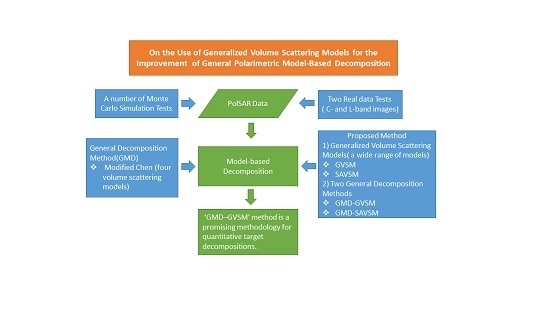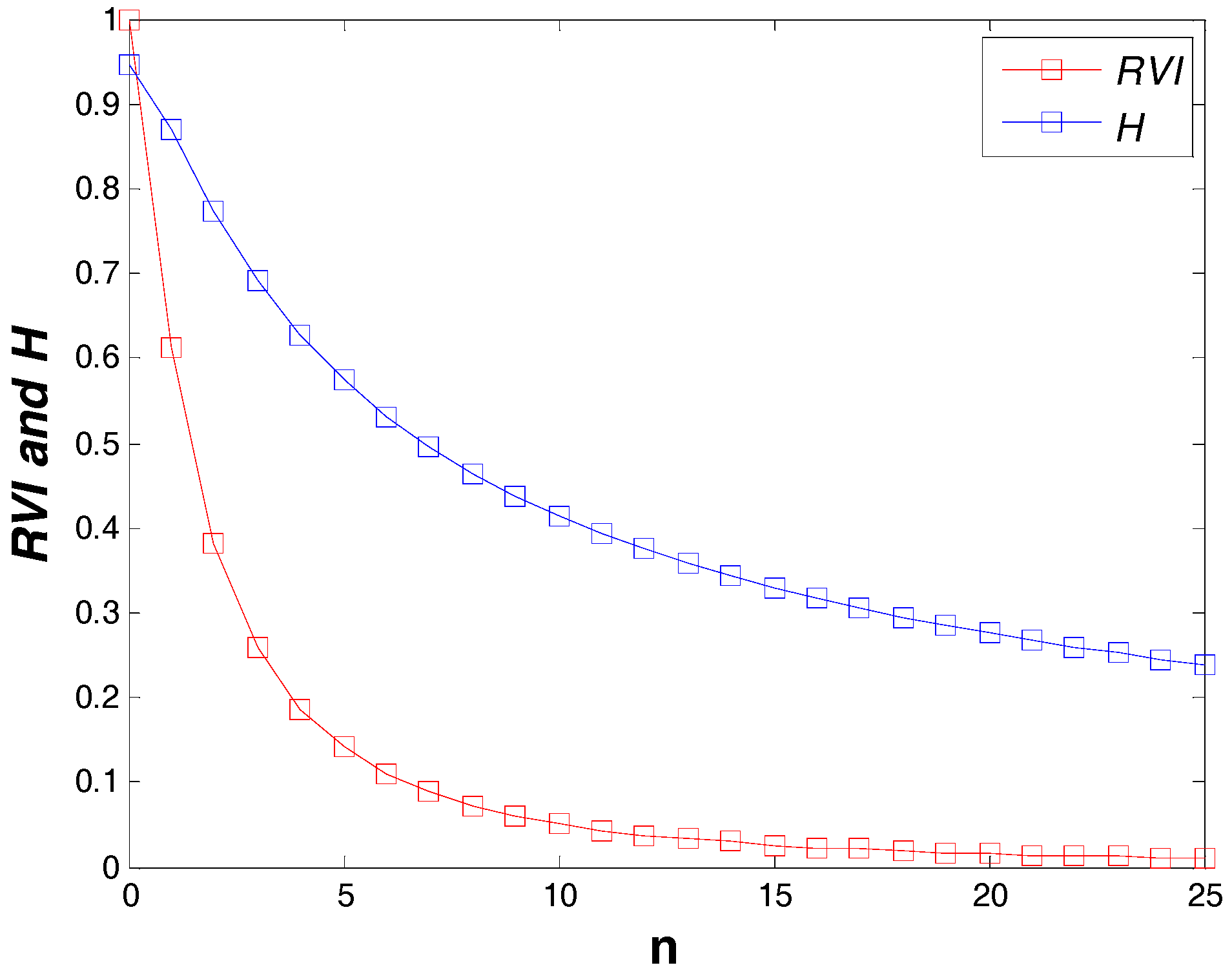On the Use of Generalized Volume Scattering Models for the Improvement of General Polarimetric Model-Based Decomposition
Abstract
:1. Introduction
2. General Polarimetric Model-Based Decomposition
2.1. General Decomposition Framework
2.2. Modified Parameters Inversion Algorithm
- (1)
- Redefining variable boundaries based on the physical constraints of dielectric constants and some implicit conditions of the model itself;
- (2)
- Generating the initial values accounting for physical constraints;
- (3)
- Implementing a transformation of variables to ease the selection of the upper and lower bounds required in the inversion algorithm.
2.3. Volume Scattering Model
2.3.1. Generalized Volume Scattering Model (GVSM)
2.3.2. Simplified Adaptive Volume Scattering Model (SAVSM)
2.4. The Proposed Modified Algorihtms
2.4.1. General Polarimetric Model-Based Decomposition with GVSM
2.4.2. General Polarimetric Model-Based Decomposition with SAVSM
3. Results
3.1. Monte Carlo Simulations
- For the four backscattering coefficients, the results of and from the “GMD–GVSM” method show significant improvements compared with the “Modified Chen” method, whereas the result of exhibits only a slight improvement. The “GMD–SAVSM” method also shows a slightly higher accuracy in the volume scattering coefficient , however, it produces slightly poorer performance in and . The results of from all three methods are very similar.
- For the two orientation angle parameters, the “GMD–GVSM” method also produces some improvement. Moreover, the accuracy of the double-bounce orientation angle is higher than the surface orientation angle reaching a high probability of 0.8 with lower RMSE. Similarly, the “GMD–SAVSM” method also shows better performance in the double-bounce orientation angle and its accuracy is better than the surface orientation angle. However, for the inversion of surface orientation angle, the “GMD–SAVSM” has not shown improvement compared with the “Modified Chen” method.
- For the two ratio parameters, the “GMD–GVSM” method shows some improvement in the absolute value of alpha, while performance slightly degrades for the phase of alpha. Although the result of beta from the “GMD–GVSM” method is slightly worse than from the original method, it is noted that it is still a reasonable estimate since the probability of success in the retrieval is 80% allowing a 0.08 RMSE value. However, the performance of “GMD–SAVSM” is clearly poorer in all ratio parameters in comparison with the other two methods.
3.2. Real Data Test
3.2.1. Radarsat-2 Satellite Data
3.2.2. AIRSAR Airborne Data
4. Discussion
4.1. Contribution to PolSAR Target Decomposition Methologies
4.2. Radar Frequency Issue
4.3. Future Research Directions
5. Conclusions
Acknowledgments
Author Contributions
Conflicts of Interest
References
- Chen, S.W.; Li, Y.Z.; Wang, X.S.; Xiao, S.P.; Sato, M. Modeling and interpretation of scattering mechanisms in polarimetric synthetic aperture radar: Advances and perspectives. IEEE Signal Process. Mag. 2014, 31, 79–89. [Google Scholar] [CrossRef]
- Cloude, S.R.; Pottier, E. A review of target decomposition theorems in radar polarimetry. IEEE Trans. Geosci. Remote Sens. 1996, 34, 498–518. [Google Scholar] [CrossRef]
- Wang, W.; Ji, Y.; Lin, X. A novel fusion-based ship detection method from Pol-SAR images. Sensors 2015, 15, 25072–25089. [Google Scholar] [CrossRef] [PubMed]
- Xiang, D.; Tang, T.; Hu, C.; Fan, Q.; Su, Y. Built-up area extraction from PolSAR imagery with model-based decomposition and polarimetric coherence. Remote Sens. 2016, 8. [Google Scholar] [CrossRef]
- Shibayama, T.; Yamaguchi, Y.; Yamada, H. Polarimetric scattering properties of landslides in forested areas and the dependence on the local incidence angle. Remote Sens. 2015, 7, 15424–15442. [Google Scholar] [CrossRef]
- Cloude, S.R.; Pottier, E. An entropy based classification scheme for land applications of polarimetric SAR. IEEE Trans. Geosci. Remote Sens. 1997, 35, 68–78. [Google Scholar] [CrossRef]
- Lee, J.S.; Grunes, M.R.; Ainsworth, T.L.; Du, L.J.; Schuler, D.L.; Cloude, S.R. Unsupervised classification using polarimetric decomposition and the complex Wishart classifier. IEEE Trans. Geosci. Remote Sens. 1999, 37, 2249–2258. [Google Scholar]
- Famil, L.F.; Pottier, E.; Lee, J.S. Unsupervised classification of multifrequency and fully polarimetric SAR images based on the H/A/Alpha-Wishart classifier. IEEE Trans. Geosci. Remote Sens. 2001, 39, 2332–2342. [Google Scholar] [CrossRef]
- Shimoni, M.; Borghys, D.; Heremans, R.; Perneel, C.; Acheroy, M. Fusion of PolSAR and PolInSAR data for land cover classification. Int. J. Appl. Earth Obs. Geoinf. 2009, 11, 169–180. [Google Scholar] [CrossRef]
- Qi, Z.; Yeh, A.G.; Li, X.; Lin, Z. A novel algorithm for land use and land cover classification using RADARSAT-2 polarimetric SAR data. Remote Sens. Environ. 2012, 118, 21–39. [Google Scholar] [CrossRef]
- Antropov, O.; Rauste, Y.; Astola, H.; Praks, J.; Hame, T.; Hallikainen, M.T. Land cover and soil type mapping from spaceborne polsar data at l-band with probabilistic neural network. IEEE Trans. Geosci. Remote Sens. 2014, 52, 5256–5270. [Google Scholar] [CrossRef]
- Hong, S.H.; Kim, H.O.; Wdowinski, S.; Feliciano, E. Evaluation of polarimetric SAR decomposition for classifying wetland vegetation types. Remote Sens. 2015, 7, 8563–8585. [Google Scholar] [CrossRef]
- Zhang, X.; Dierking, W.; Zhang, J.; Meng, J. A polarimetric decomposition method for ice in the bohai sea using C-band PolSAR data. IEEE J. Sel. Top. Appl. Earth Obs. Remote Sens. 2015, 8, 47–66. [Google Scholar] [CrossRef]
- Hajnsek, I.; Pottier, E.; Cloude, S.R. Inversion of surface parameters from polarimetric SAR. IEEE Trans. Geosci. Remote Sens. 2003, 41, 727–744. [Google Scholar] [CrossRef]
- Hajnsek, I.; Jagdhuber, T.; Schon, H.; Papathanassiou, K.P. Potential of estimating soil moisture under vgetation cover by means of PolSAR. IEEE Trans. Geosci. Remote Sens. 2009, 47, 442–454. [Google Scholar] [CrossRef]
- Jagdhuber, T.; Hajnsek, I.; Papathanassiou, K.P. An iterative generalized hybrid decomposition for soil moisture retrieval under vegetation cover using fully polarimetric SAR. IEEE J. Sel. Top. Appl. Earth Obs. Remote Sens. 2015, 8, 3911–3922. [Google Scholar] [CrossRef]
- Freeman, A.; Durden, S.L. A three-component scattering model for polarimetric SAR data. IEEE Trans. Geosci. Remote Sens. 1998, 36, 963–973. [Google Scholar] [CrossRef]
- Yamaguchi, Y.; Moriyama, T.; Ishido, M.; Yamada, H. Four-component scattering model for polarimetric SAR image decomposition. IEEE Trans. Geosci. Remote Sens. 2005, 43, 1699–1706. [Google Scholar] [CrossRef]
- Yamaguchi, Y.; Sato, A.; Boerner, W.M.; Sato, R.; Yamada, H. Four-component scattering power decomposition with rotation of coherency matrix. IEEE Trans. Geosci. Remote Sens. 2011, 49, 2251–2258. [Google Scholar] [CrossRef]
- Sato, A.; Yamaguchi, Y.; Singh, G.; Park, S.E. Four-component scattering power decomposition with extended volume scattering model. IEEE Geosci. Remote Sens. Lett. 2012, 9, 166–170. [Google Scholar] [CrossRef]
- Singh, G.; Yamaguchi, Y.; Park, S.E. General four-component scattering power decomposition with unitary transformation of coherency matrix. IEEE Trans. Geosci. Remote Sens. 2013, 51, 3014–3022. [Google Scholar] [CrossRef]
- Chen, S.W.; Wang, X.S.; Xiao, S.P.; Sato, M. General polarimetric model-based decomposition for coherency matrix. IEEE Trans. Geosci. Remote Sens. 2014, 52, 1843–1855. [Google Scholar] [CrossRef]
- Xie, Q.H.; Ballester-Berman, J.D.; Lopez-Sanchez, J.M.; Zhu, J.J.; Wang, C.C. Monte Carlo simulation tests for general polarimetric model-based decomposition method from the perspective of quantitative application. In Proceedings of the 11th European Conference on Synthetic Aperture Radar (EUSAR2016), Hamburg, Germany, 6–9 June 2016; pp. 1–4.
- Xie, Q.H.; Ballester-Berman, J.D.; Lopez-Sanchez, J.M.; Zhu, J.J.; Wang, C.C. Quantitative analysis of polarimetric model-based decomposition methods. Remote Sens. 2016, 8. [Google Scholar] [CrossRef]
- Antropov, O.; Rauste, Y.; Hame, T. Volume scattering modeling in POLSAR decompositions: Study of ALOS PALSAR data over boreal forest. IEEE Trans. Geosci. Remote Sens. 2011, 49, 3838–3848. [Google Scholar] [CrossRef]
- Huang, X.D.; Wang, J.F.; Shang, J.L. An adaptive two-component model-based decomposition on soil moisture estimation for C-band Radarsat-2 imagery over wheat fields at early growing stages. IEEE Geosci. Remote Sens. Lett. 2016, 13, 414–418. [Google Scholar] [CrossRef]
- Huang, X.D.; Wang, J.F.; Shang, J.L. An integrated surface parameter inversion scheme over agricultural fields at early growing stages by means of C-band polarimetric Radarsat-2 imagery. IEEE Trans. Geosci. Remote Sens. 2016, 54, 2510–2528. [Google Scholar] [CrossRef]
- An, W.T.; Cui, Y.; Yang, J. Three-component model-based decomposition for polarimetric SAR data. IEEE Trans. Geosci. Remote Sens. 2010, 48, 2732–2739. [Google Scholar]
- Kim, Y.; van Zyl, J. Comparison of forest parameter estimation techniques using SAR data. In Proceedings of the IEEE 2001 International Geoscience and Remote Sensing Symposium (IGARSS2011), Sydney, Australia, 9–13 July 2001; pp. 1395–1397.
- Lee, J.S.; Ainsworth, T.L. The effect of orientation angle compensation on coherency matrix and polarimetric target decompositions. IEEE Trans. Geosci. Remote Sens. 2011, 49, 53–64. [Google Scholar] [CrossRef]
- Lee, J.S.; Pottier, E. Polarimetric Radar Imaging: From Basics to Applications; CRC Press: Boca Raton, FL, USA, 2009. [Google Scholar]
- Zou, B.; Lu, D.; Zhang, L.; Moon, W.M. Eigen-Decomposition-Based Four-Component Decomposition for PolSAR Data. IEEE J. Sel. Top. Appl. Earth Obs. Remote Sens. 2016, 9, 1286–1296. [Google Scholar] [CrossRef]
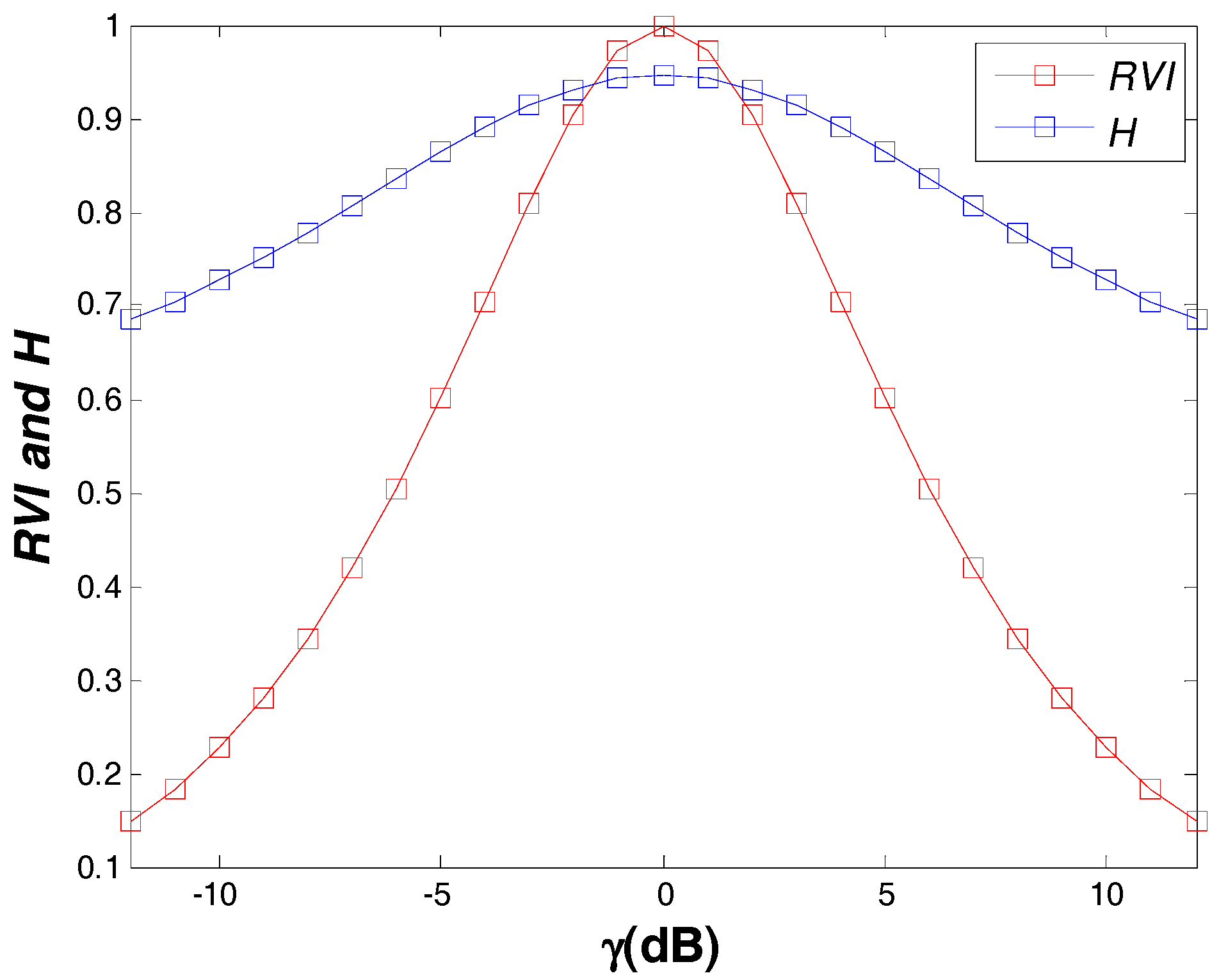

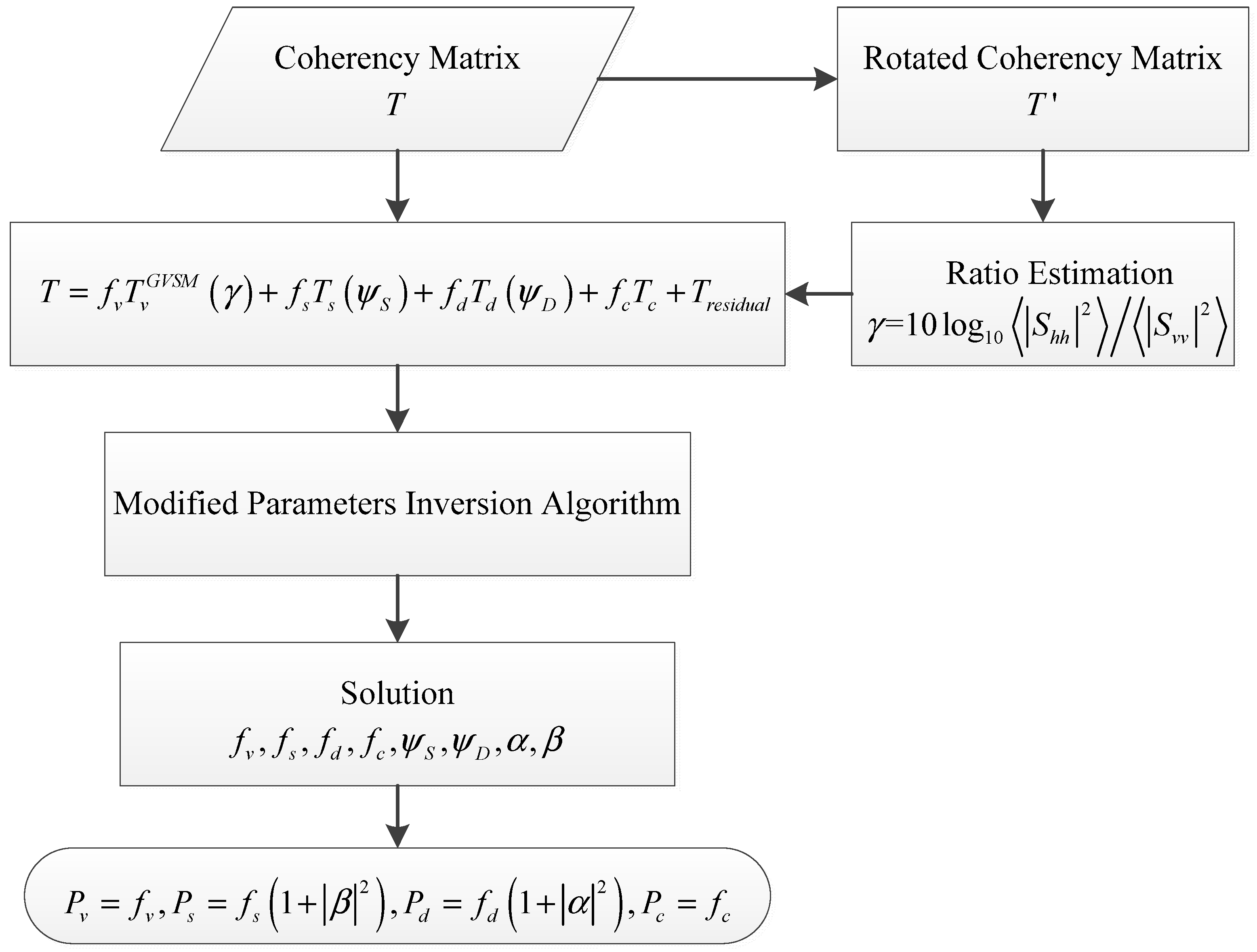
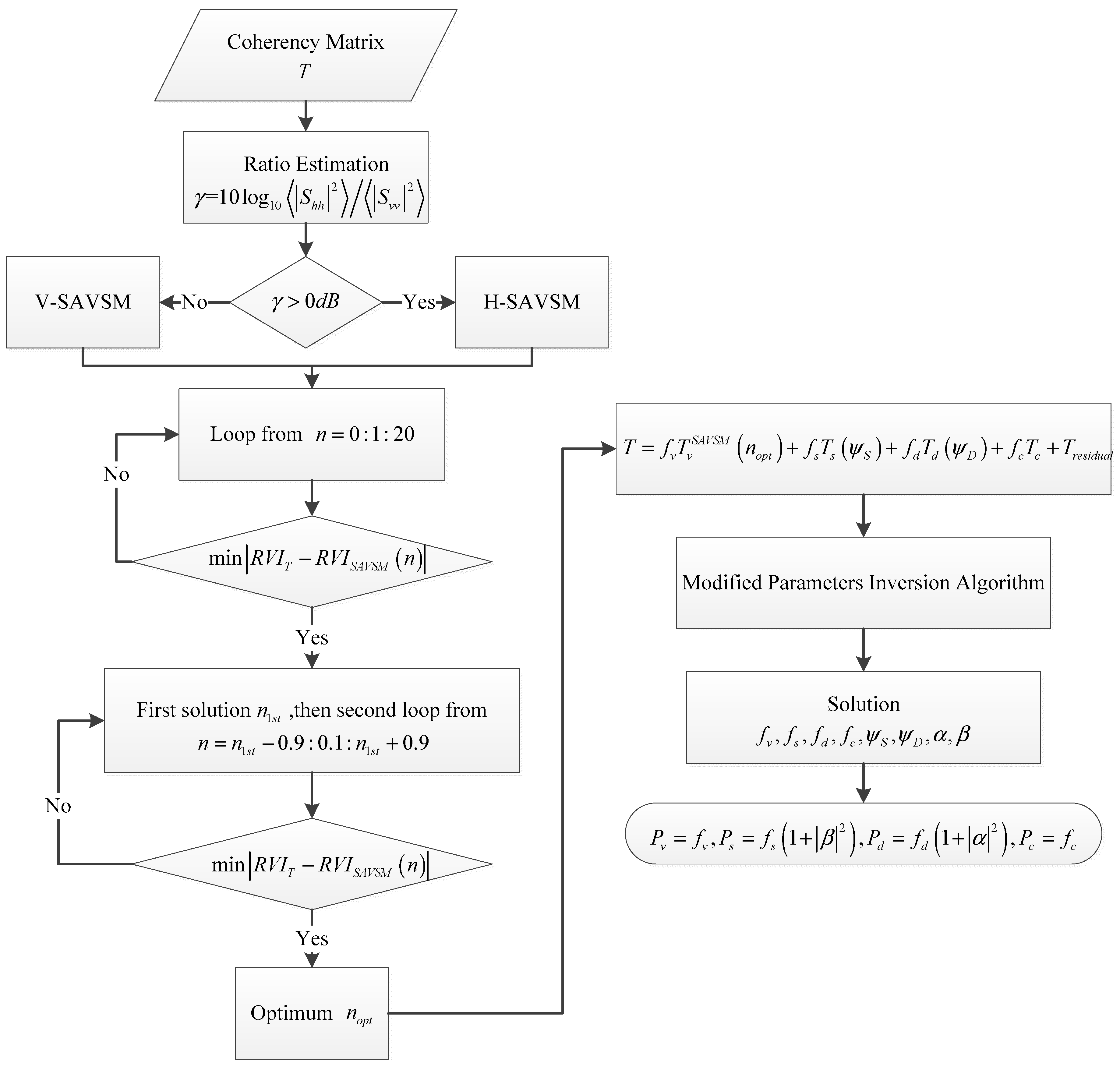
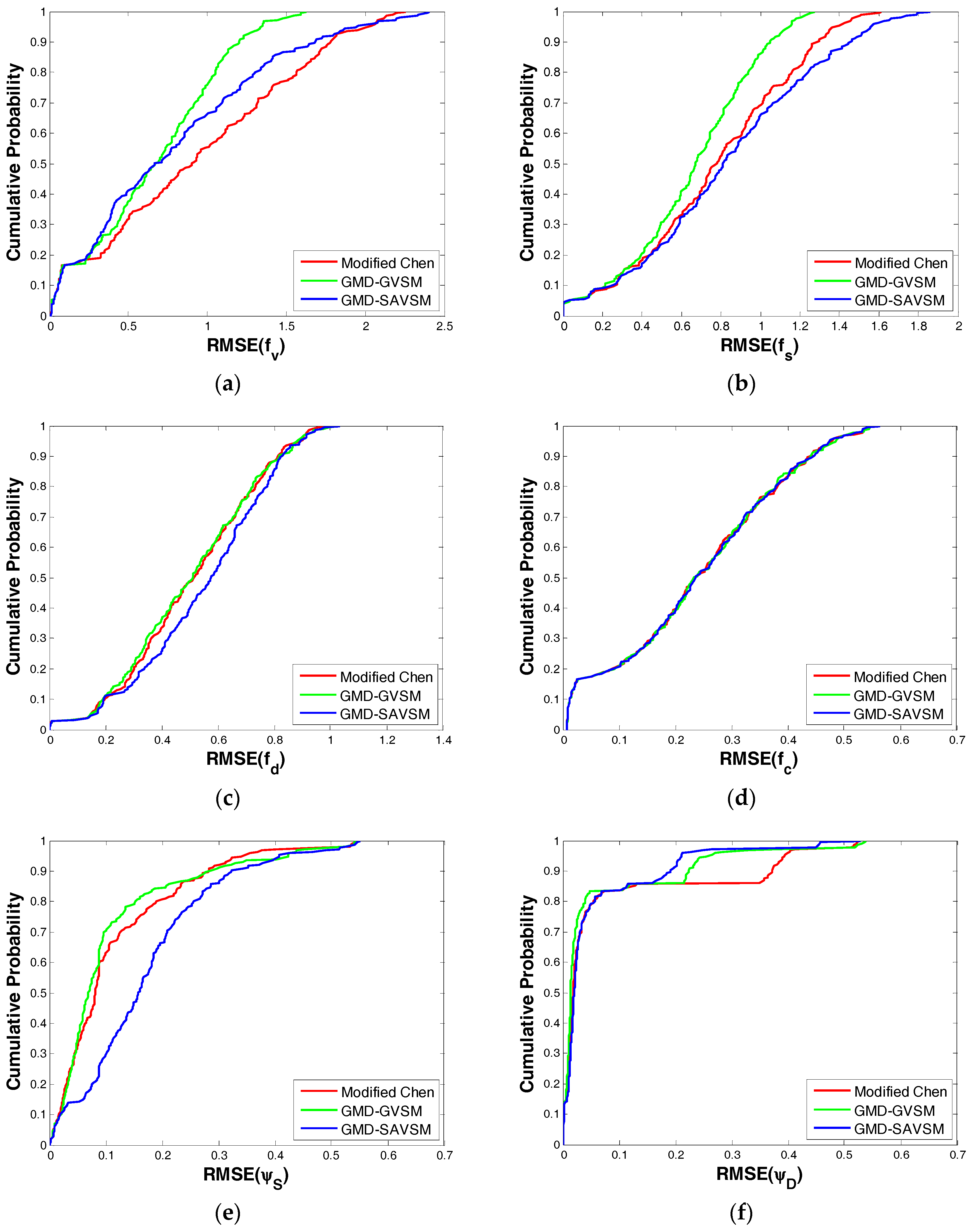
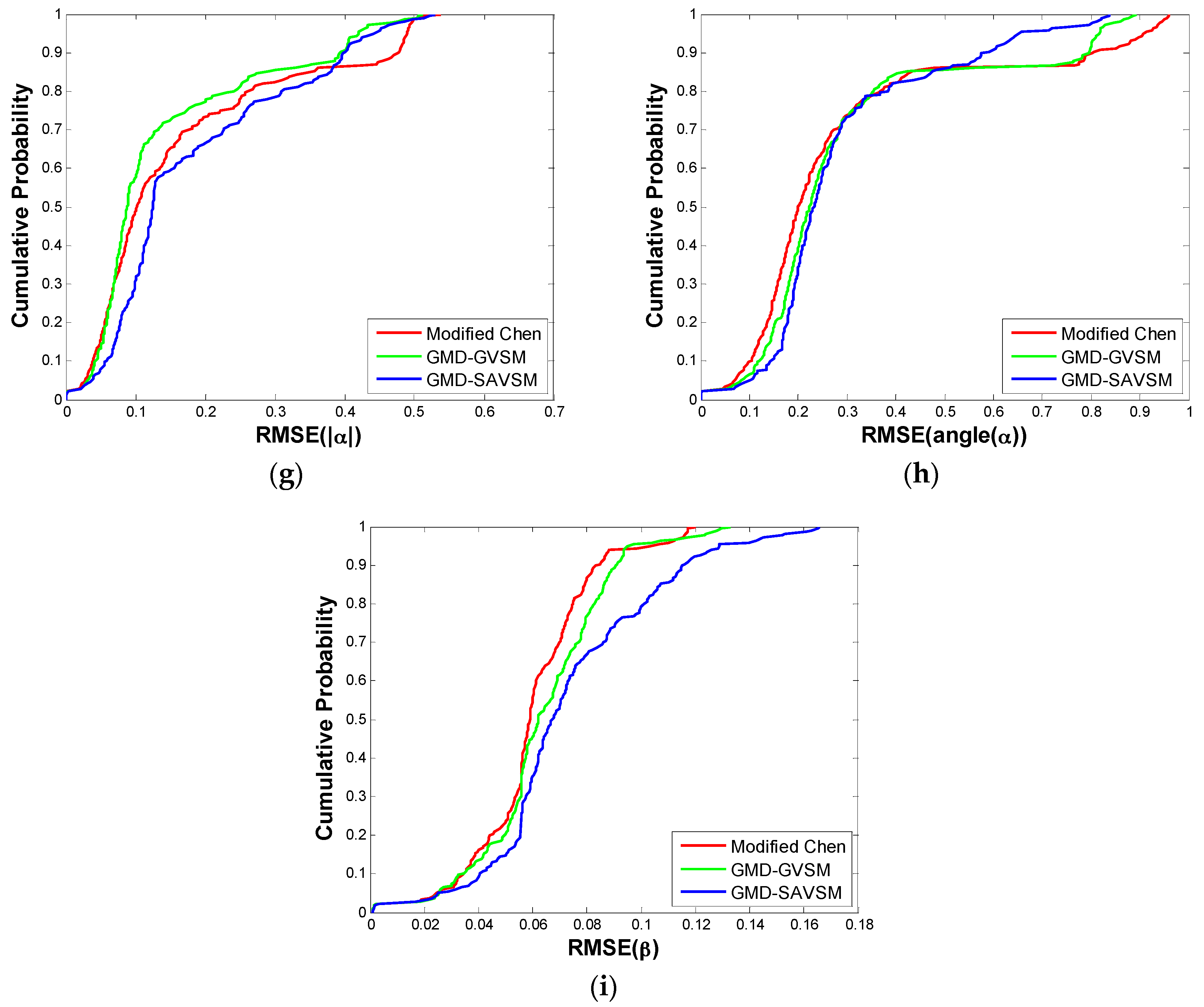
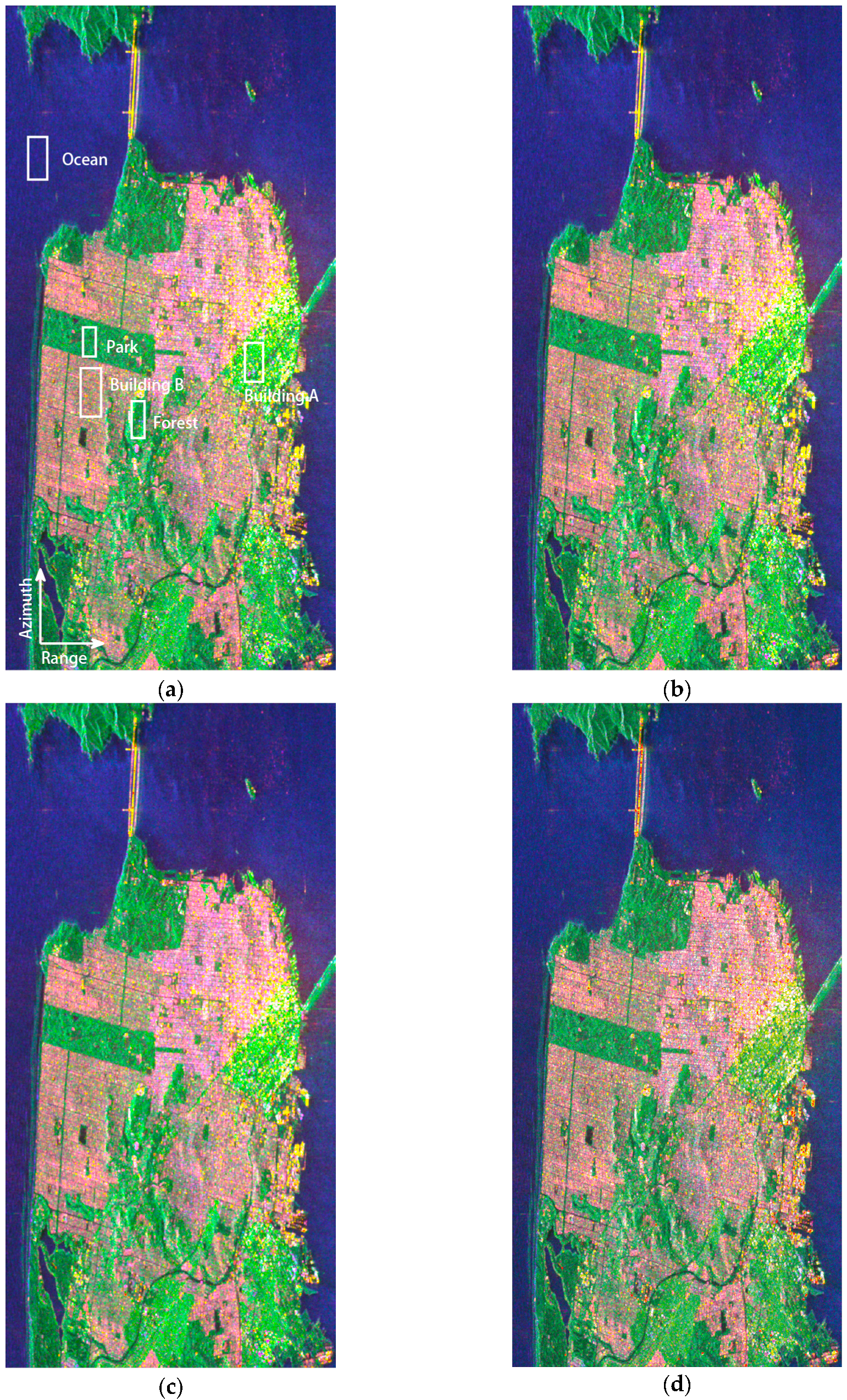
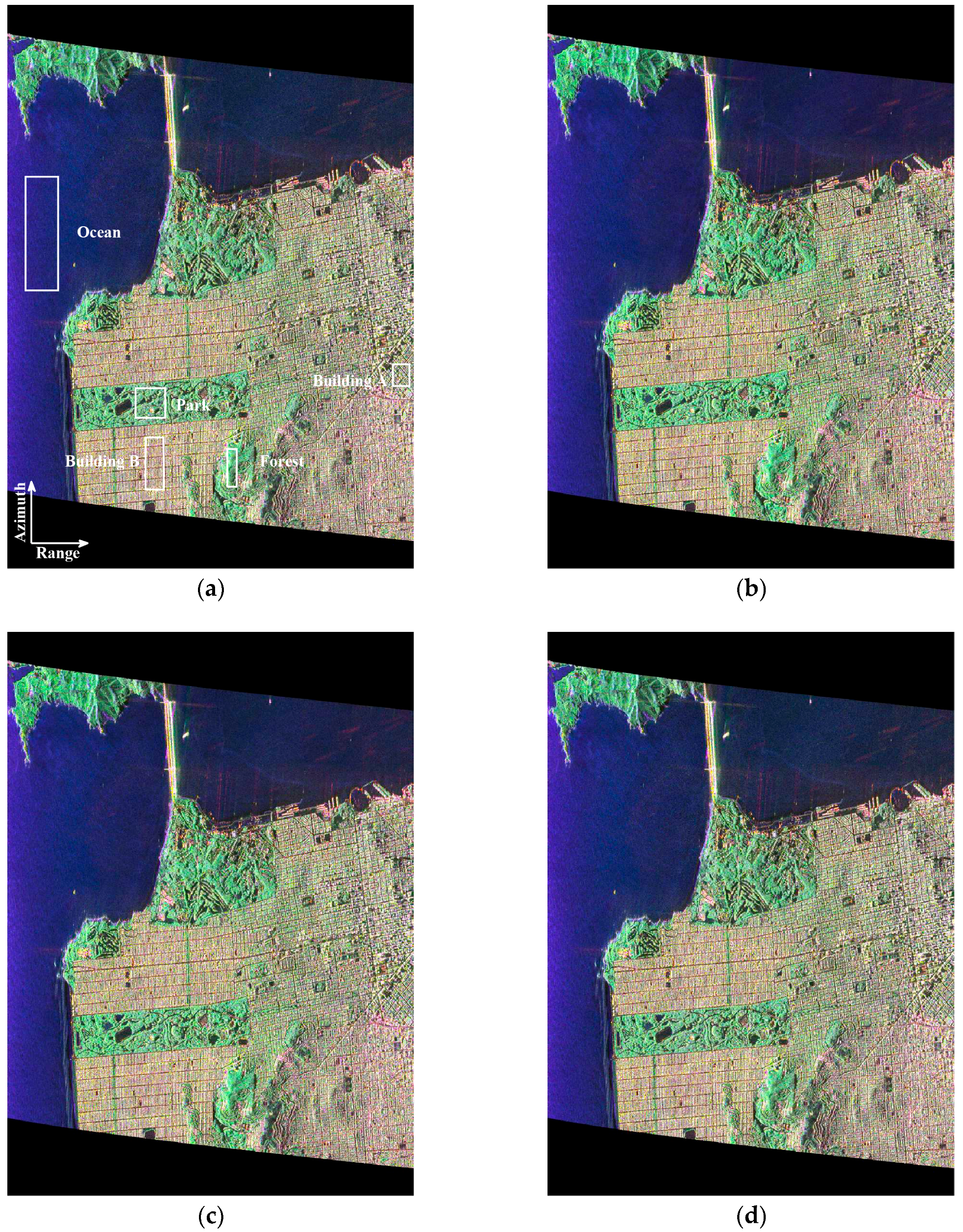
| Parameter | Quantity | Value |
|---|---|---|
| volume scattering coefficient | 0:2:10 | |
| surface scattering coefficient | 0:2:10 | |
| dihedral scattering coefficient | 0:2:10 | |
| helix scattering coefficient | 0.01 | |
| orientation angle in surface scattering model | −10° | |
| orientation angle in dihedral scattering model | −15° | |
| ratio parameter in dihedral scattering model | 0.3515–0.0768i | |
| ratio parameter in surface scattering model | −0.3377 | |
| incidence angle | 45° | |
| differential propagation phase | 10° | |
| soil dielectric constant | 10 | |
| trunk dielectric constant | 30 |
| Area | Methods | Ps(%) | Pd(%) | Pv(%) | Pc(%) |
|---|---|---|---|---|---|
| Forest | Y4R | 35.98 | 13.72 | 45.21 | 5.09 |
| Modified Chen | 34.71 | 22.48 | 37.73 | 5.08 | |
| GMD–GVSM | 32.48 | 21.02 | 41.40 | 5.10 | |
| GMD–SAVSM | 33.81 | 21.76 | 39.30 | 5.12 | |
| Park | Y4R | 29.31 | 11.51 | 53.21 | 5.97 |
| Modified Chen | 29.88 | 20.09 | 44.06 | 5.97 | |
| GMD–GVSM | 26.47 | 18.75 | 48.79 | 5.99 | |
| GMD–SAVSM | 28.77 | 19.80 | 45.40 | 6.03 | |
| Build-up A | Y4R | 20.51 | 35.34 | 37.53 | 6.62 |
| Modified Chen | 20.10 | 40.57 | 32.74 | 6.59 | |
| GMD–GVSM | 19.73 | 40.95 | 32.66 | 6.66 | |
| GMD–SAVSM | 20.31 | 42.04 | 30.94 | 6.71 | |
| Build-up B | Y4R | 33.48 | 48.35 | 14.15 | 4.01 |
| Modified Chen | 25.27 | 56.83 | 13.89 | 4.00 | |
| GMD–GVSM | 26.54 | 55.15 | 14.29 | 4.01 | |
| GMD–SAVSM | 27.75 | 53.53 | 14.68 | 4.04 | |
| Ocean | Y4R | 95.12 | 1.86 | 2.60 | 0.41 |
| Modified Chen | 93.39 | 4.52 | 1.68 | 0.41 | |
| GMD–GVSM | 93.33 | 4.52 | 1.74 | 0.41 | |
| GMD–SAVSM | 93.01 | 4.43 | 2.15 | 0.41 |
| Area | Methods | Ps(%) | Pd(%) | Pv(%) | Pc(%) |
|---|---|---|---|---|---|
| Forest | Y4R | 27.81 | 18.59 | 44.92 | 8.68 |
| Modified Chen | 27.36 | 29.30 | 34.66 | 8.68 | |
| GMD–GVSM | 26.20 | 28.67 | 36.43 | 8.70 | |
| GMD–SAVSM | 26.17 | 28.55 | 36.57 | 8.71 | |
| Park | Y4R | 29.43 | 29.20 | 34.71 | 6.66 |
| Modified Chen | 24.93 | 40.21 | 28.21 | 6.65 | |
| GMD–GVSM | 24.67 | 39.50 | 29.16 | 6.67 | |
| GMD–SAVSM | 25.15 | 37.83 | 30.34 | 6.68 | |
| Build-up A | Y4R | 30.99 | 37.60 | 24.74 | 6.67 |
| Modified Chen | 27.22 | 49.62 | 16.59 | 6.57 | |
| GMD–GVSM | 27.34 | 49.11 | 16.96 | 6.59 | |
| GMD–SAVSM | 26.03 | 47.18 | 20.20 | 6.59 | |
| Build-up B | Y4R | 21.41 | 59.42 | 16.10 | 3.07 |
| Modified Chen | 15.53 | 68.22 | 13.19 | 3.06 | |
| GMD–GVSM | 16.25 | 66.32 | 14.37 | 3.06 | |
| GMD–SAVSM | 16.18 | 62.05 | 18.70 | 3.07 | |
| Ocean | Y4R | 93.85 | 1.86 | 3.52 | 0.77 |
| Modified Chen | 91.82 | 5.35 | 2.06 | 0.77 | |
| GMD–GVSM | 91.71 | 5.31 | 2.21 | 0.77 | |
| GMD–SAVSM | 91.18 | 5.31 | 2.75 | 0.76 |
© 2017 by the authors. Licensee MDPI, Basel, Switzerland. This article is an open access article distributed under the terms and conditions of the Creative Commons Attribution (CC BY) license ( http://creativecommons.org/licenses/by/4.0/).
Share and Cite
Xie, Q.; Ballester-Berman, J.D.; Lopez-Sanchez, J.M.; Zhu, J.; Wang, C. On the Use of Generalized Volume Scattering Models for the Improvement of General Polarimetric Model-Based Decomposition. Remote Sens. 2017, 9, 117. https://doi.org/10.3390/rs9020117
Xie Q, Ballester-Berman JD, Lopez-Sanchez JM, Zhu J, Wang C. On the Use of Generalized Volume Scattering Models for the Improvement of General Polarimetric Model-Based Decomposition. Remote Sensing. 2017; 9(2):117. https://doi.org/10.3390/rs9020117
Chicago/Turabian StyleXie, Qinghua, J. David Ballester-Berman, Juan M. Lopez-Sanchez, Jianjun Zhu, and Changcheng Wang. 2017. "On the Use of Generalized Volume Scattering Models for the Improvement of General Polarimetric Model-Based Decomposition" Remote Sensing 9, no. 2: 117. https://doi.org/10.3390/rs9020117




